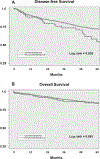Influence of carcinoid syndrome on the clinical characteristics and outcomes of patients with gastroenteropancreatic neuroendocrine tumors undergoing operative resection
- PMID: 30377003
- PMCID: PMC10182411
- DOI: 10.1016/j.surg.2018.09.008
Influence of carcinoid syndrome on the clinical characteristics and outcomes of patients with gastroenteropancreatic neuroendocrine tumors undergoing operative resection
Abstract
Background: The incidence, clinical characteristics, and long-term outcomes of patients with gastroenteropancreatic neuroendrocrine tumors and carcinoid syndrome undergoing operative resection have not been well characterized.
Methods: Patients undergoing resection of primary or metastatic gastroenteropancreatic neuroendrocrine tumors between 2000 and 2016 were identified from an 8-institution collaborative database. Clinicopathologic and postoperative characteristics as well as overall survival and disease-free survival were compared among patients with and without carcinoid syndrome.
Results: Among 2,182 patients who underwent resection, 139 (6.4%) had preoperative carcinoid syndrome. Patients with carcinoid syndrome were more likely to have midgut primary tumors (44.6% vs 21.4%, P < .001), lymph node metastasis (63.4% vs 44.3%, P < .001), and metastatic disease (62.8% vs 26.7%, P < .001). There was no difference in tumor differentiation, grade, or Ki67 status. Perioperative carcinoid crisis was rare (1.6% vs 0%, P < .01), and the presence of preoperative carcinoid syndrome was not associated with postoperative morbidity (38.8% vs 45.5%, P = .129). Substantial symptom improvement was reported in 59.5% of patients who underwent curative-intent resection, but occurred in only 22.7% who underwent debulking. Despite an association on univariate analysis (P = .04), carcinoid syndrome was not independently associated with disease-free survival after controlling for confounding factors (hazard ratio 0.97, 95% confidence interval 0.64-1.45). Preoperative carcinoid syndrome was not associated with overall survival on univariate or multivariate analysis.
Conclusion: Among patients undergoing operative resection of gastroenteropancreatic neuroendrocrine tumors, the prevalence of preoperative carcinoid syndrome was low. Although operative intervention with resection or especially debulking in patients with carcinoid syndrome was disappointing and often failed to improve symptoms, after controlling for markers of tumor burden, carcinoid syndrome was not independently associated with worse disease-free survival or overall survival.
Copyright © 2018 Elsevier Ltd. All rights reserved.
Figures
References
-
- Ito T, Igarashi H, Nakamura K, et al. Epidemiological trends of pancreatic and gastrointestinal neuroendocrine tumors in Japan: a nationwide survey analysis. J Gastroenterol. 2015;50:58–64. - PubMed
-
- Soga J. Carcinoids and their variant endocrinomas. An analysis of 11842 reported cases. J Exp Clin Cancer Res. 2003;22:517–530. - PubMed
Publication types
MeSH terms
Supplementary concepts
Grants and funding
LinkOut - more resources
Full Text Sources
Medical


